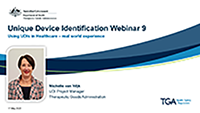The government is now operating in accordance with the Guidance on Caretaker Conventions, pending the outcome of the 2025 federal election.
Disclaimer
These presentation papers are provided on the TGA's website solely for the purpose of indicating or suggesting what TGA representatives spoke about to the various conferences and seminars to which it relates. The papers are not legislative in nature and should not be taken to be statements of any law or policy in any way.
The Australian Government Department of Health (of which the TGA is a part) advises that (a) the presentation papers should not be relied upon in any way as representing a comprehensive description of regulatory requirements, and (b) cannot guarantee, and assumes no legal liability or responsibility for, the accuracy, currency or completeness of the information contained in the presentation paper.
Presentation
- Presented by: Michelle Van Wijk - Unique Device Identification Project Manager, TGA
Mark Songhurst - Programme lead, Scan4Safety Programme, The Leeds Teaching Hospitals NHS Trust
Kirk Kikirekov - Managing Director of Prospitalia h-trak
- Presented at: Online
- Presentation date: Tuesday 17 May 2022
- Presentation summary: Guest speakers will present on their experiences in implementing UDI in healthcare.




